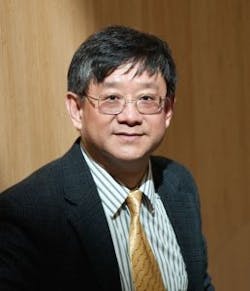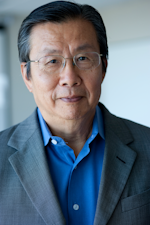Business Forum: Collaboration and excellence are the keys to educating photonics professionals

I interviewed Professor Xi-Cheng Zhang, director of the Institute of Optics at the University of Rochester because it is a leading optical center that has made a major impact on the optics and photonics community.
Xi-Cheng Zhang is the M. Parker Givens Professor, and he also holds professorships and honorary appointments at several other universities because he is an internationally recognized scientist and a leader in terahertz science and technology.
He was chosen to be the director of the Institute of Optics in 2012 after a successful 20-year career at Rensselaer Polytechnic Institute (RPI), where he founded the Center for THz Research and was co-founder of Zomega Terahertz (East Greenbush, NY). A prolific author and speaker, Dr. Zhang is a Fellow of AAAS, APS, IEEE, OSA, and SPIE, and is the recipient of many honors and awards.
Milton Chang: We associate the Institute of Optics with giants like Professor Emil Wolf and Professor Rudolf Kingslake in optical sciences and Professor Bob Hopkins in optical engineering; tell us more about the Institute.
X-C Zhang: The Institute of Optics is an academic department within the Hajim School of Engineering and Applied Sciences at the University of Rochester. The Institute of Optics has a unique culture and a rich history. Established in 1929, the Institute was the first university to offer optics degrees in the U.S.-and the Institute has awarded over 2800 optics degrees since. Our faculty and graduates have started more than 200 optics companies since Prof. Hopkins founded Tropel in Rochester in 1953.
MC: What is your vision going forward?
XCZ: We have been fortunate to have professors such as Kingslake, Hopkins, and Wolf. We are continuing their legacy to provide the finest education and frontier research in the optics and photonics community. Bearing in mind we are a research university, our Institute’s leadership can only be maintained by having a top research portfolio, quality faculty, and cutting-edge research. We continue to offer unique optics and photonics courses to our students, and we constantly modify the curriculum to reflect advances in science and to meet the demands of society. My vision is to continue this tradition of excellence, to attract the very best undergraduate and graduate students, and to educate the highest quality professionals for the future optics and photonics community. We are fortunate to have a superior faculty, extremely bright and motivated students, and a large pool of involved alumni.
MC: What are the challenges/opportunities you see?
XCZ: A major challenge in today’s economy is shrinking funding for research. We also have to compete for the best students given there are more universities that grant optics degrees: Arizona, CREOL, Alabama, the Rose-Hulman Institute of Technology, and other schools such as Stanford, Harvard, and Duke now have strong photonics programs. We have to be more collaborative, more aggressive. On the flip side, we have the opportunity to team up with other schools to pool knowledge and ideas and attract large-size funding to take on group projects. The growth potential becomes a true advantage for all of us and for the U.S. as a whole.
This same competition is occurring internationally and at a growing rate. There are excellent optics programs in Europe, and optics and photonics programs in China are definitely growing.
MC: What new initiatives you would like to undertake?
XCZ: It is crucial to create large-size research centers in the current environment. Our Institute has historically established some large research centers, such as the Center for Electronic Imaging Science, the Center for Optics Manufacturing, and Multidisciplinary University Research Initiative (MURI) grants. Even the Laboratory for Laser Energetics has roots in optics and mechanical engineering. Today, we have The Hopkins Center, which focuses on undergraduate education; the NSF Center for Freeform Optics; the Center for Vision Science; and the Center for Quantum Information (jointly with Physics). We are also working to create new centers in optical engineering and optical science.
I foresee advancement in a variety of areas: quantum optics, biophotonics, and optical manufacturing. My experience in building the Terahertz Center at RPI gives me great optimism for the goals we are working towards at Rochester.
MC: The Institute for Manufacturing Innovation just announced by DOD will no doubt be beneficial to the Institute of Optics in these areas. Any specific goals you want to take on during your tenure as director of the institute?
XCZ: I would like to have more endowed professorships to honor and recognize contributions of our current faculty, to recruit star professors, and to get research funding. In addition to the professorships, I would like to create more graduate scholarships. Our goal is to have 10 to 15 endowed graduate scholarships in three years. We have five now. We also want to have more Masters students in the coming years. We have just signed agreements with several international universities to grant double MS degrees (degrees from both universities).
On the educational side, we plan to develop 12–16 textbooks to cover both optical physics and optical engineering. We will record our unique and best lectures into textbooks for the general optics and photonics community.
We are externally focused, too. We will increase our Industrial Associates (IA) members and strengthen our Industrial Associates Program, which was established by Professor Brian Thompson in 1974. We will enhance communication with industrial companies to continue to provide the workforce they need. We will continue to play key roles in the National Photonics Initiative, the National Technology Roadmap for Photonics, etc.
MC: What are the significant trends you see in technology and the position of optics and engineering in society? What of competition/collaboration between countries?
XCZ: Mega research and education programs increasingly attract major funding. Larger, major activities need critical mass. Collaboration between universities and countries is increasing.
Social and professional media brings the circle ever closer. I envision a future where international cooperation leads to revolutionary breakthroughs in technology and medical areas. Our Institute hosts many international researchers, and our faculty also uses academic leaves to spend quality research time with colleagues in foreign countries. I personally visited and interacted with major photonics and optics organizations domestically and in more than 20 countries and have served as advisor and reviewer for numerous research and educational programs.
To bring together the very best academic leaders in optics, we organized the first Optical Leadership Summit during FiO/LS: 2012 in Rochester. There, current and former deans and directors of the Colleges and Institute agreed on a goal to strengthen collaboration and cooperation between major optics programs and extend the summit worldwide. Maintaining these connections will provide important insight, links, and opportunities to understand the overall academic challenges and define promising technologies. I envision a future where this kind of international cooperation leads to revolutionary breakthroughs in technology and educational areas.
MC: Advice for students in learning, career, life?
XCZ: I encourage students to set “blue sky” goals. Be ambitious; set your sights higher than you first think you may achieve. If you don’t try, you definitely will not reach the goal, but if you give your best effort, you will make progress and you may surprise yourself with what you really can achieve.

Milton Chang
MILTON CHANG of Incubic Management was president of Newport and New Focus. He is currently director of mBio Diagnostics and Aurrion; a trustee of Caltech; a member of the SEC Advisory Committee on Small and Emerging Companies; and serves on advisory boards and mentors entrepreneurs. Chang is a Fellow of IEEE, OSA, and LIA. Direct your business, management, and career questions to him at [email protected], and check out his book Toward Entrepreneurship at www.miltonchang.com.